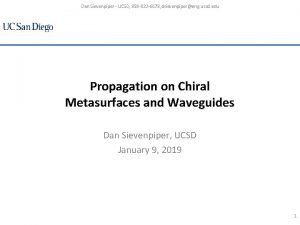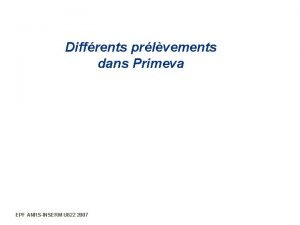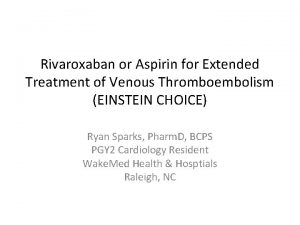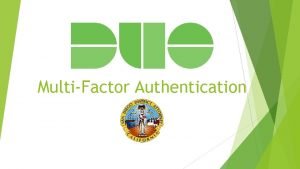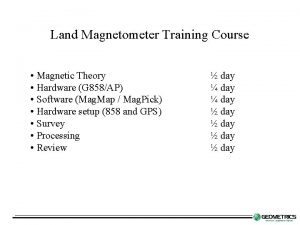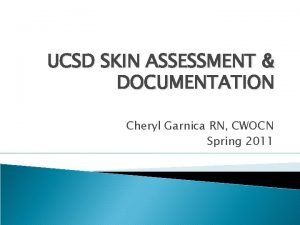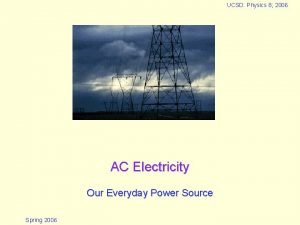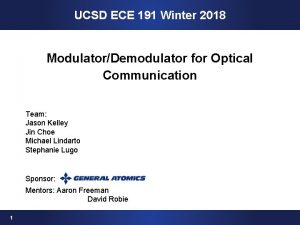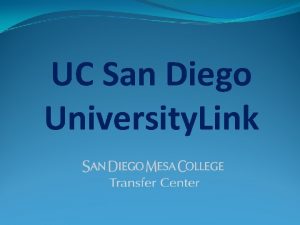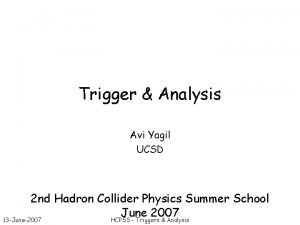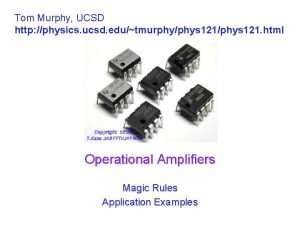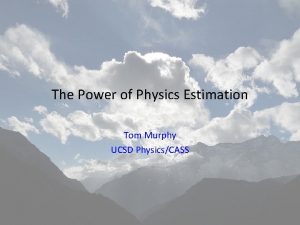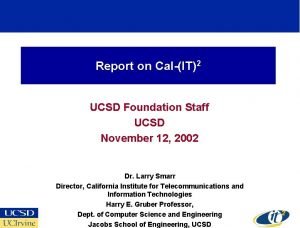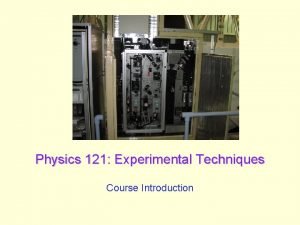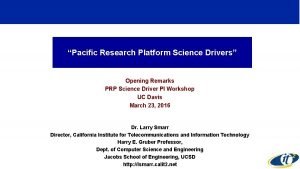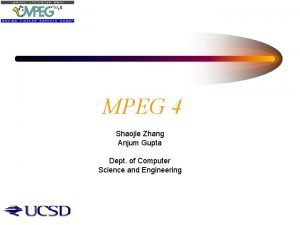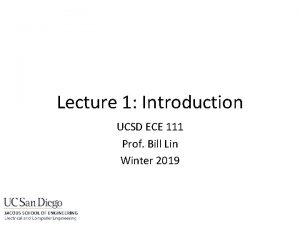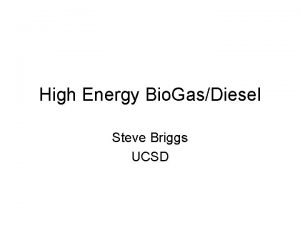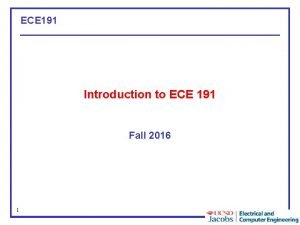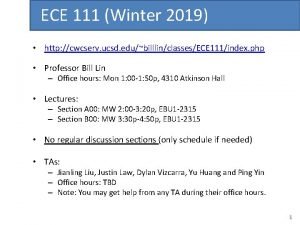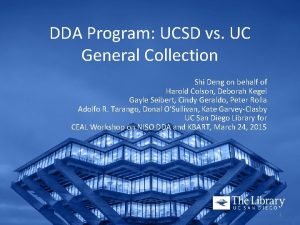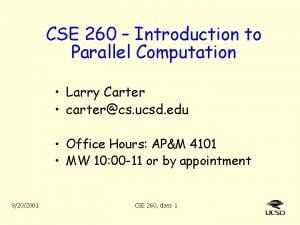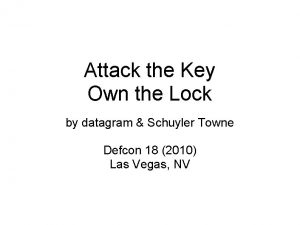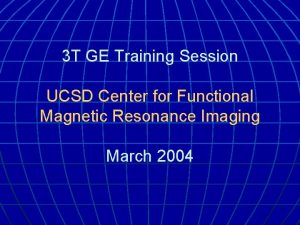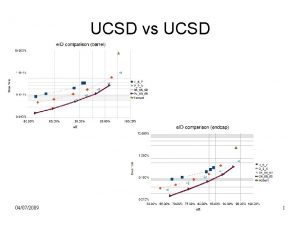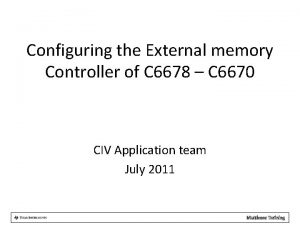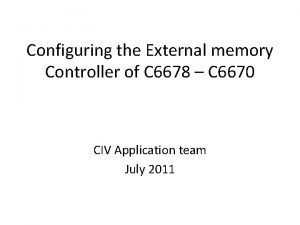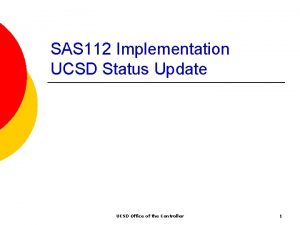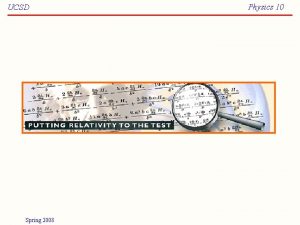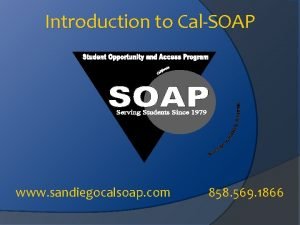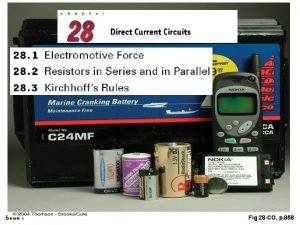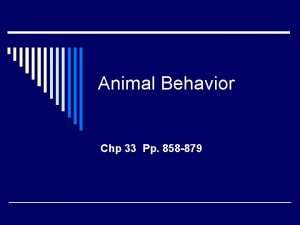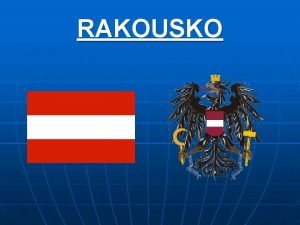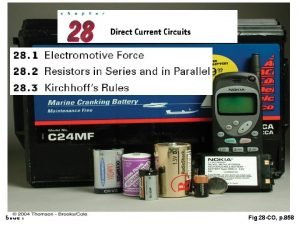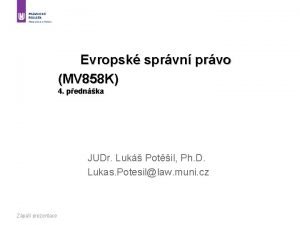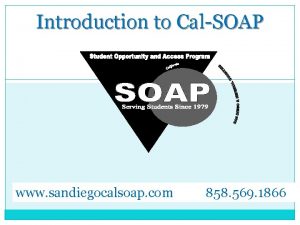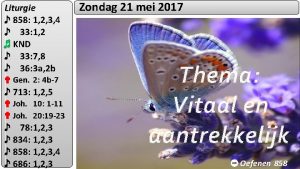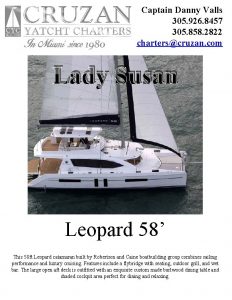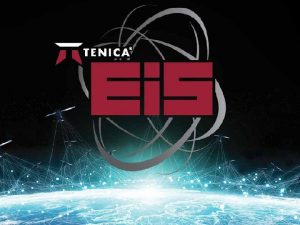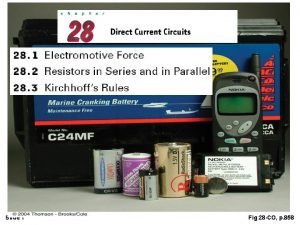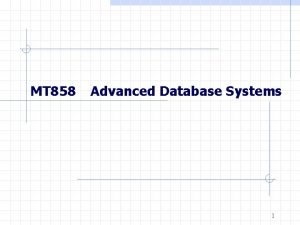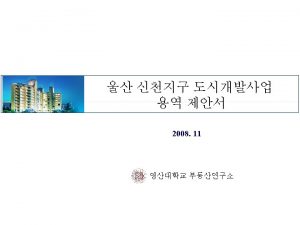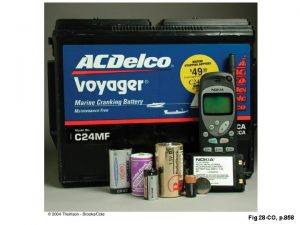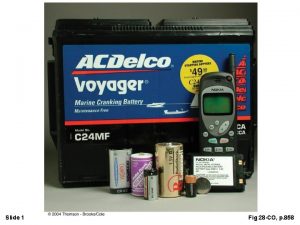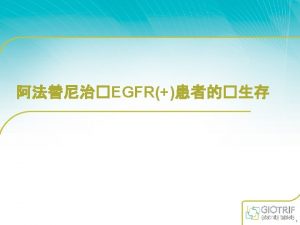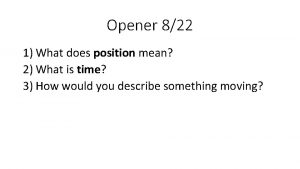Dan Sievenpiper UCSD 858 822 6678 dsievenpipereng ucsd




























- Slides: 28

Dan Sievenpiper - UCSD, 858 -822 -6678, dsievenpiper@eng. ucsd. edu Propagation on Chiral Metasurfaces and Waveguides Dan Sievenpiper, UCSD January 9, 2019 1

Dan Sievenpiper - UCSD, 858 -822 -6678, dsievenpiper@eng. ucsd. edu From Artificial Dielectrics to Topological Metamaterials Artificial Dielectrics Photonic Crystals Metamaterials Sharpless 1940 s to 1960 s Yablonovitch et. al. 1980 s and 1990 s Smith et. al. 2000 s Metal strips, plates, or spheres in dielectric change effective permittivity Specific lattices (periodicity) can create band gaps (omnidirectional frequency filters) • Resonance can create any value of permittivity and/or permeability, including negative or near zero Photonic Topological Insulators Shvets et. al. 2010 s ”Spin-orbit coupling” for unidirectional modes (two opposite polarizations propagate in opposite directions) Topological electromagnetic structures represent the next advancement and new degree of freedom in artificial media or metamaterials 2

Dan Sievenpiper - UCSD, 858 -822 -6678, dsievenpiper@eng. ucsd. edu Some Early Metasurfaces Frequency Selective Surfaces Soft/Hard Surfaces Corrugated Surfaces Bed of Nails e. g. hard horn Forbid or allow both TM and TE modes High Impedance Surface Control transmission Stop propagation and reflection versus of surface waves frequency when grooves are l/4 deep (open circuit condition) • Omnidirectional, but allows propagation of TE mode Artificial Magnetic Conductor These lead to four basic boundary conditions in electromagnetics: electric conductor, magnetic conductor, soft surface, and hard surface 3

Dan Sievenpiper - UCSD, 858 -822 -6678, dsievenpiper@eng. ucsd. edu Artificial Impedance Surfaces Holographic • • Conformal Anisotropic Electronically Steerable Have demonstrated holographic, electrically tunable, and anisotropic surfaces Has grown to significant research topic at many universities and companies. 4

Dan Sievenpiper - UCSD, 858 -822 -6678, dsievenpiper@eng. ucsd. edu Active Metasurfaces Nonlinear Absorber • Self-Tuning Surface Self-Focusing Surface Broadband Non-Foster Based Surface A wide range of new surface properties are enabled by including nonlinear, active, feedback, or non-Foster circuits 5

Dan Sievenpiper - UCSD, 858 -822 -6678, dsievenpiper@eng. ucsd. edu Controlled Guiding and Scattering with Anisotropic Impedance Surfaces Surface Waveguide Wave attached to surface waveguide • • Waveguide transparent to other directions Artificial Scattering Edge Scattering redirected to angle of artificial edge Horizontal polarization Vertical polarization Anisotropic waveguides can be non-scattering for other directions Defined boundaries between regions can control plane wave scattering 6

Dan Sievenpiper - UCSD, 858 -822 -6678, dsievenpiper@eng. ucsd. edu Patterning Technique for Arbitrary Inhomogeneous Anisotropic Surfaces Impedance Function Extract Unit Cell Shift Dots Using Impedance Gradient Lattice of Dots Equivalent Rectangle From Inertial Moment Impedance Curve Impedance Tensor @Target frequency Impedance Propagating length • • Pattern Using Voronoi Technique Transverse length Points are shifted according to local gradient of desired impedance function Cells are drawn around points using Voronoi technique 7

Dan Sievenpiper - UCSD, 858 -822 -6678, dsievenpiper@eng. ucsd. edu Examples of Patterned Anisotropic Metasurfaces for Various Functions Bend Around Curve Beam Shifter Planar Lens Avoiding Hole • Patterning method allows for wide range of impedance functions • Enables control over surface wave propagation and radiation 8

Dan Sievenpiper - UCSD, 858 -822 -6678, dsievenpiper@eng. ucsd. edu Recent Results on Cloaking a Hole Ordinary Ground Plane Leakage Through Hole Patterned Surface Wave Passes Around Hole • Patterned surface spreads out impinging waves to avoid the aperture • Can be used to minimize scattering from openings or obstacles 9

Dan Sievenpiper - UCSD, 858 -822 -6678, dsievenpiper@eng. ucsd. edu Line Wave Concept – Analogous to Surface Waves but One Dimension Lower Line Wave ZTM Surface φ Sin ZTE Surface gul arit y y x z • We can confine & guide wave along an infinitesimal line between impedance surfaces. • Does not require any bulk material nor any enclosing structure. • Analogous to surface wave but 1 D. Conceivably the smallest waveguide possible. 10

Dan Sievenpiper - UCSD, 858 -822 -6678, dsievenpiper@eng. ucsd. edu Implementation: Capacitive and Inductive Frequency Selective Surfaces Measurement setup Zoom-In Measured Dispersion Curves “Li Inductive ne W Sheet ave ZTM ” Capacitive Sheet ZTE Inductive Sheet • Implemented using inductive grid and capacitive patches • Any complementary pair of FSS can also work • Note that the cell size must be modified to account for the dielectric substrate 11

Dan Sievenpiper - UCSD, 858 -822 -6678, dsievenpiper@eng. ucsd. edu Broad Bandwidth Operation and Measurement of Field Profile Wave confined over 2 octaves • • Field “singularity” – not quite infinite, but highly concentrated Measured data shows that line waveguide operates over about 2 octaves Only limited by the metal pattern used to implement the surface impedance 12

Dan Sievenpiper - UCSD, 858 -822 -6678, dsievenpiper@eng. ucsd. edu Important Properties and Structures that can be Built with Line Waves Directional Coupler Simple Bend • Magic-T Compensated Bend Many classic microwave and optical structures can be built Ring Resonator One-way propagation 13

Dan Sievenpiper - UCSD, 858 -822 -6678, dsievenpiper@eng. ucsd. edu Approximate Mathematical Description of Line Waves Cross-section View TM TE Zoom-In • 14

Dan Sievenpiper - UCSD, 858 -822 -6678, dsievenpiper@eng. ucsd. edu General Solution for Arbitrary Impedances: Sommerfeld-Maliuzhinets Transform Sommerfeld-Maliuzhinets transform incident angle in driven mode (known) eigenvalue in eigenmode (unknown) where • • Solution exists for scattering of free-space plane waves from impedance wedge using Sommerfeld-Maliuzhinets transform Adapt solution to case where: – The two impedances on each side of the wedge are different – The wedge is unfolded into flat surface – Waves are bound to the interface between the two impedances (cos b >1)

Dan Sievenpiper - UCSD, 858 -822 -6678, dsievenpiper@eng. ucsd. edu Comparison between analytical solution and numerical solution Analytical: COMSOL: • Results match COMSOL simulation, validating analytical solution

Dan Sievenpiper - UCSD, 858 -822 -6678, dsievenpiper@eng. ucsd. edu Photonic Topological Insulators and One-way Propagation Vertically flipped structure Switched mode symmetry (dipole/quadrupole) Gyromagnetic materials Acoustic example • • Described by analogy with electronic topological insulators Requires starting with photonic band gap One-directional interface modes created at boundaries Several approaches to varying design on either side of interface: – Flip symmetry of structure on either side of interface – Switch mode type (dipole/quadrupole) on either side of interface – Can involve magnetic materials (nonreciprocal) or not (reciprocal) 17

Dan Sievenpiper - UCSD, 858 -822 -6678, dsievenpiper@eng. ucsd. edu Characterization of Photonic Topological Insulators • • Joining two materials with different Chern numbers results in edge states Polarization of mode is locked to direction of propagation 18

Dan Sievenpiper - UCSD, 858 -822 -6678, dsievenpiper@eng. ucsd. edu Topological Electromagnetics in Simple Metal Patterns “Spin type” Photonic Topological Insulator “Valley type” Photonic Topological Insulator K’ K Ez-Hz Spin-down bandgap Ez+Hz Spin-up • • • Γ K Various types of symmetry inversions can create one-directional interface modes without magnetic materials These differ from the line waves because of the bulk band gap Tradeoff between bandwidth and radiation into the bulk surfaces or surrounding space 19

Dan Sievenpiper - UCSD, 858 -822 -6678, dsievenpiper@eng. ucsd. edu Chiral versus Gyrotropic Materials Chiral Material (Preferred Handedness) Gyrotropic Material (Constant Direction of Rotation) Rotates to right X Rotates to left e. g. Only Supports Right Hand Propagation • • • Mirror Flips Right to Left Reciprocal (time reversal symmetry) Reduced backward propagation because left hand polarization is inhibited by right hand chiral medium Could potentially find scatterers that enable coupling of forward to backward mode • • • Microwave Circulator B Rotates to right Rotates to left Flip Hexagonal Lattice • • • Nonreciprocal (build isolators, circulators, etc. ) Can make truly one-directional edge modes with lattice of circulators (one implementation of photonic topological insulator) Mechanical and acoustic analogs also exist (circulating fluids, gyroscopes) Both can support one-directional propagation through different mechanisms Only the gyrotropic material is actually nonreciprocal, due to magnetic field Other nonreciprocal techniques: cyclic modulation, gain/loss (”PT symmetry”) 20

Dan Sievenpiper - UCSD, 858 -822 -6678, dsievenpiper@eng. ucsd. edu Physical Implementation of Chiral Metasurfaces supporting Helical Surface waves: • Lattice of simple L-shaped apertures in metal surface • Excite with small circularly polarized source in the center • LCP propagates forward, RCP propagates backward on 1 diagonal RCP excitation • • • LCP excitation Chiral metasurface can support extended surface wave or collimated beam Polarization is locked to direction of propagation Band gap not required – similar to line wave but not bound to any interface 21

Dan Sievenpiper - UCSD, 858 -822 -6678, dsievenpiper@eng. ucsd. edu Band Structure of Chiral Metasurfaces and Calculation of Spin Vector Forward Wave Spin-up Backward Wave 1 Spin-down • • Spin vector is a simple way to characterize modes in either eigenmode simulations or driven mode simulations Chiral metasurfaces have opposite spins for opposite directions of propagation 22

Dan Sievenpiper - UCSD, 858 -822 -6678, dsievenpiper@eng. ucsd. edu Spin Filtering on Omega Surface Ex+j. Ey Spin Vector Ex-j. Ey Excite with Ex • Polarization beam splitter for circularly polarized surface waves 23

Dan Sievenpiper - UCSD, 858 -822 -6678, dsievenpiper@eng. ucsd. edu Understanding Propagation in Terms of Band Structure Omega Pattern 16 GHz • 23 GHz Equifrequency Contours 30 GHz 40 GHz Two oppositely polarized beams form and then change angle with frequency 24

Dan Sievenpiper - UCSD, 858 -822 -6678, dsievenpiper@eng. ucsd. edu Beam Collimation on Homogeneous Chiral Metasurfaces Omega Patches L Shape Slots Z Shape Slots Non. Chiral • Flatness of equifrequency contours determines beam collimation • Similar behavior seen in hyperbolic metasurfaces 25

Dan Sievenpiper - UCSD, 858 -822 -6678, dsievenpiper@eng. ucsd. edu Beam Steering by Sequentially Rotated Half Circle Patches 1 • Rotating partial circles provides control over beam propagation • Could be used to route surface waves into absorbing structures 26

Dan Sievenpiper - UCSD, 858 -822 -6678, dsievenpiper@eng. ucsd. edu Surface Wave on Chiral 2 -D Surface Ex+Ey, kx-ky Ex+Ey, kx+ky 1 Spin down-> LCP • • Plane waves appear to produce directional field patterns Spin of local field depends on direction of incoming plane wave Spin Up -> RCP 27

Dan Sievenpiper - UCSD, 858 -822 -6678, dsievenpiper@eng. ucsd. edu Next Steps • Determine proper effective impedance tensor for chiral metasurfaces (several approaches exist) and find boundary that reproduces behavior of unit cell designs • Understand scattering from chiral surfaces, and excitation and propagation of surface waves on them • Explore inclusion of gyrotropic materials to make robust and nonreciprocal metasurfaces (e. g. isolator surface) • Determine fundamental limitations, optimize desings, and identify applications 28
 Dan sievenpiper
Dan sievenpiper U-822
U-822 Rct-822
Rct-822 Multi factor authentication overview
Multi factor authentication overview Geometrics g-858
Geometrics g-858 Geisel library fallen star
Geisel library fallen star Skin assessment documentation
Skin assessment documentation Ucsd physics courses
Ucsd physics courses Transformer physics definition
Transformer physics definition Ece 191 ucsd
Ece 191 ucsd Uc campus link
Uc campus link Avi yagil ucsd
Avi yagil ucsd Tom murphy ucsd
Tom murphy ucsd Fermi problem
Fermi problem Lisa murphy ucsd
Lisa murphy ucsd Ucsd foundation
Ucsd foundation Physics courses ucsd
Physics courses ucsd Jupyterhub ucsd
Jupyterhub ucsd Bisp 197
Bisp 197 Anjum gupta ucsd
Anjum gupta ucsd Ucsd ece 111
Ucsd ece 111 Steve briggs ucsd
Steve briggs ucsd Ucsd ece 191
Ucsd ece 191 Ece 111 ucsd
Ece 111 ucsd Dda collections
Dda collections Ucsd cse 3
Ucsd cse 3 Ucsd cse 260
Ucsd cse 260 Mta skeleton key
Mta skeleton key Tps ucsd
Tps ucsd
